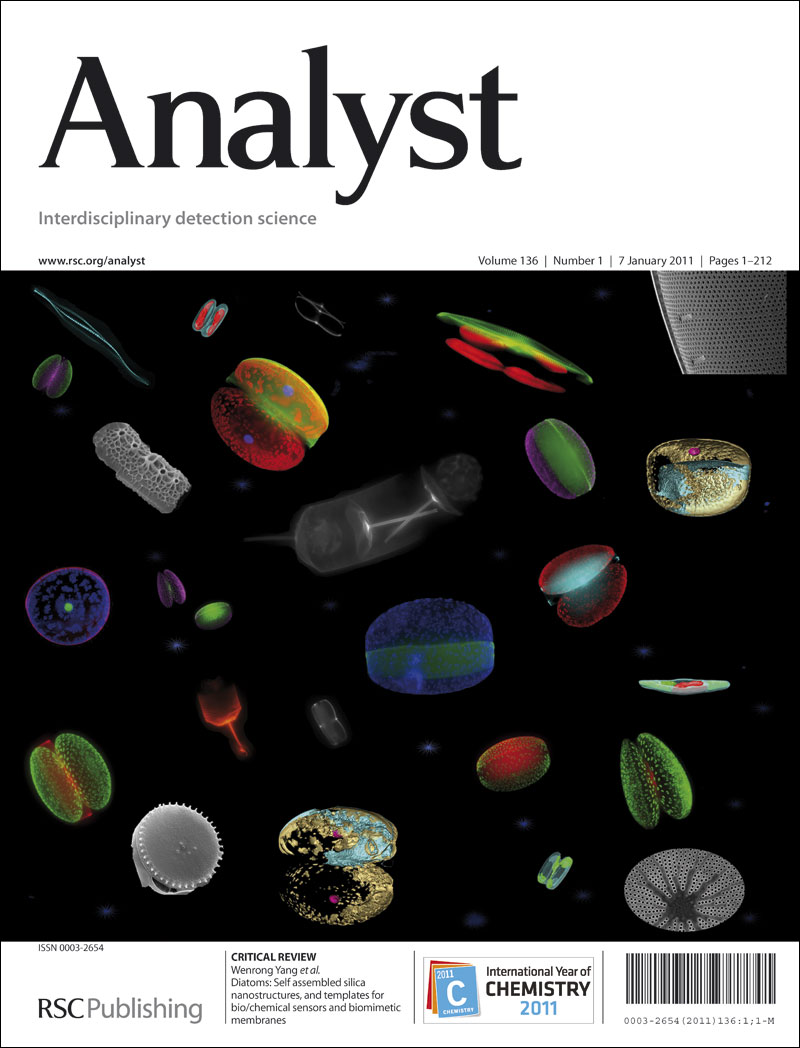基于表面压印针灸针的 SARS-CoV-2 核壳蛋白电化学微传感器
IF 3.6
3区 化学
Q2 CHEMISTRY, ANALYTICAL
引用次数: 0
摘要
在传统针灸针(AN)上构建了一种新型电化学微传感器,用于监测SARS-CoV-2-N蛋白的生物标志物。该糖蛋白中的顺式二醇与4-巯基苯基硼酸(4-MPBA)中的苯硼酸之间的硼酸键有效地发挥了可逆相互作用。利用这种相互作用将SARS-CoV-2-N蛋白固定在4-MPBA上,4-MPBA通过S-Au键共价自组装到电沉积的AuNPs上。然后在蛋白模板周围电聚合Meldola蓝。模板洗脱后,在聚蜜蓝(pMB)层内生成与蛋白质互补的三维纳米空腔。有趣的是,纳米空腔可以为外部[Fe(CN)6]3−/4−的电子转移发挥通道作用,并且在重组SARS-CoV-2-N蛋白后,电化学探针的信号可以被阻碍,这为该生物标志物的检测奠定了平台。对影响因素进行优化后,制备的微传感器在0.1 ~ 1000 ng mL−1的线性范围内,最低检出限为0.01 ng mL−1 (S/N = 3),特别是聚合物基体厚度相关因素对微传感器的传感能力有显著影响。合适的厚度对传感信号是有效的,这与表面印迹聚合物的行为相对应。该微传感器具有较高的灵敏度和选择性,可实际检测血清样品中的SARS-CoV-2-N蛋白,对电化学微传感器和针刺技术的发展具有重要的科学意义。本文章由计算机程序翻译,如有差异,请以英文原文为准。
An electrochemical microsensor of the SARS-CoV-2 nucleocapsid protein based on surface-imprinted acupuncture needle
A novel electrochemical microsensor is constructed on a traditional acupuncture needle (AN) and used to monitor a biomarker of the SARS-CoV-2-N protein. The reversible interaction of the borate bond between the cis-diol in this glycoprotein and the phenylboronic acid in 4-mercaptophenylboronic acid (4-MPBA) is effectively exerted. This interaction was applied to anchor the SARS-CoV-2-N protein onto 4-MPBA, which is covalently self-assemblied onto electrodeposited AuNPs by the S-Au bond. Meldola blue was then electropolymerized around the protein template. After the template was eluting, three-dimensional nanocavities complementary with the protein were generated within the polymelola blue (pMB) layer. Interestingly, nanocavities could play a channel role for the electron-transfer of outer [Fe(CN)6]3−/4−, and the signal of electrochemical probe could be hindered after recombining the SARS-CoV-2-N protein, which laid a platform for the detection of this biomarker. After optimizing the influencing factors, the prepared microsensor exhibits a linear range of 0.1 ~ 1000 ng mL−1 with a low detection limit of 0.01 ng mL−1 (S/N = 3). In particular, the sensing ability was dramatically affected by the thickness correlative factors for the polymer matrix. The suitable thickness is effective for the sensing signals, which corresponds to the behavior of surface-imprinted polymer. The microsensor showed comparatively high sensitivity and selectivity and practically detected the SARS-CoV-2-N protein in the serum sample, which is of scientific significance for the development of the electrochemical microsensor and acupuncture.
求助全文
通过发布文献求助,成功后即可免费获取论文全文。
去求助
来源期刊

Analyst
化学-分析化学
CiteScore
7.80
自引率
4.80%
发文量
636
审稿时长
1.9 months
期刊介绍:
"Analyst" journal is the home of premier fundamental discoveries, inventions and applications in the analytical and bioanalytical sciences.
 求助内容:
求助内容: 应助结果提醒方式:
应助结果提醒方式:


